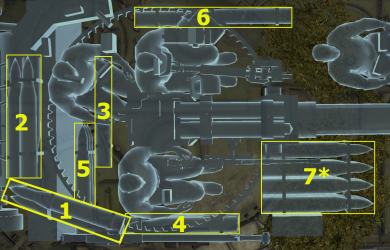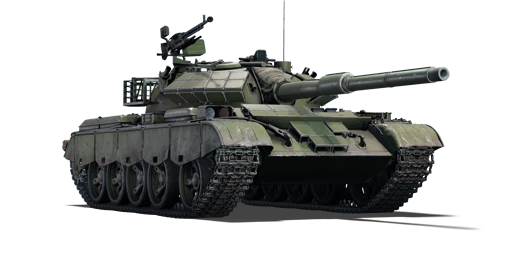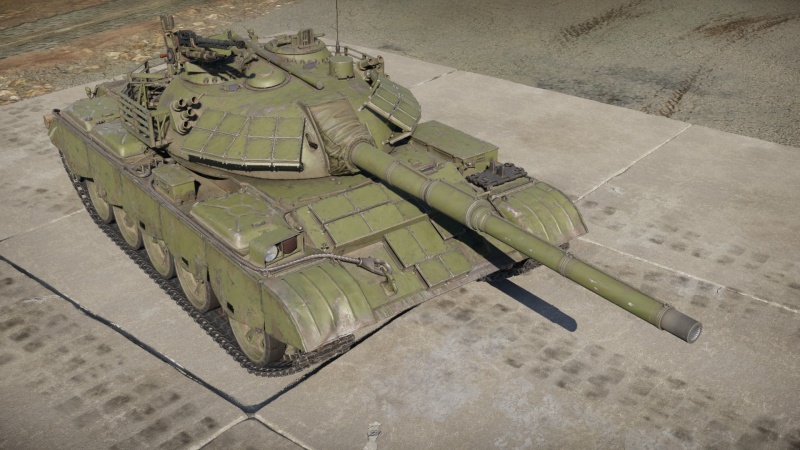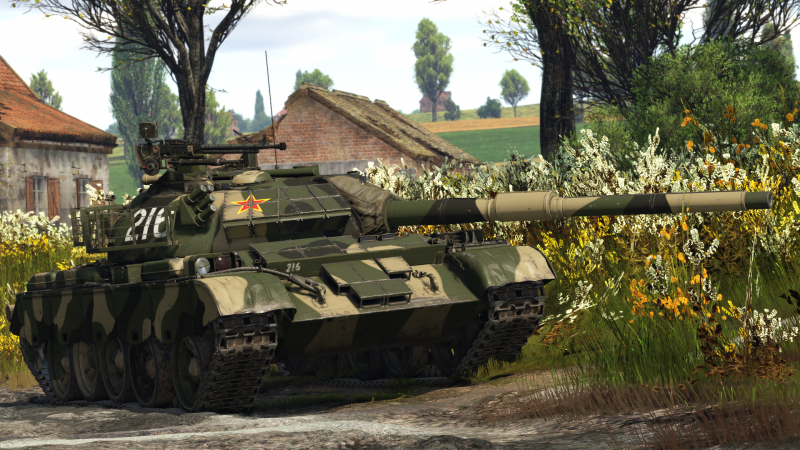Difference between revisions of "ZTZ59D1"
Colok76286 (talk | contribs) (→Machine guns: Changed to Type 54 (12.7 mm)) |
(→Machine guns) |
||
| Line 135: | Line 135: | ||
! Mount !! Capacity (Belt) !! Fire rate !! Vertical !! Horizontal | ! Mount !! Capacity (Belt) !! Fire rate !! Vertical !! Horizontal | ||
|- | |- | ||
| − | | Pintle || 250 (50) || 600 || - | + | | Pintle || 250 (50) || 600 || -4°/+82° || ±180° |
|- | |- | ||
|} | |} | ||
| Line 144: | Line 144: | ||
! Mount !! Capacity (Belt) !! Fire rate !! Vertical !! Horizontal | ! Mount !! Capacity (Belt) !! Fire rate !! Vertical !! Horizontal | ||
|- | |- | ||
| − | | Coaxial || 3,500 (250) || 600 || | + | | Coaxial || 3,500 (250) || 600 || - || - |
|- | |- | ||
|} | |} | ||
Revision as of 16:13, 12 March 2023
| This page is about the Chinese medium tank ZTZ59D1. For other versions, see ZTZ59 (Family). |
Contents
Description
The ZhuangJia Tanke ZhuZhan 59D1 is a rank VI Chinese medium tank with a battle rating of 8.3 (AB/RB/SB). It was introduced in Update 1.91 "Night Vision".
The ZTZ59D1 is a comprehensive upgrade of the venerable Type 59. It includes a large number of modern features on a old chassis, rather like an AK-47 decked out with modern furniture and accessories. The most noticeable difference at a first glance are the ERA arrays on the hull and turret cheeks. The original 100 mm Type 59 cannon has been replaced with a licensed copy of the ubiquitous Royal Ordnance L7 105 mm cannon, and the installation of thermal sights and a laser rangefinder give the tank impressive firepower. Unfortunately it still suffers from many of the Type 59's weaknesses, namely subpar mobility and gun handling. While it is not very suited to the high-speed combat common at its rank, a skilled and careful tanker can still enjoy it as a formidable sniper.
The ZTZ59D1 is succeeded by the ZTZ96, a significantly more modern design with better firepower, mobility, and protection.
General info
Survivability and armour
Armour type:
- Rolled homogeneous armour (Hull, Turret roof)
- Cast homogeneous armour (Turret, Gun mantlet)
| Armour | Front (Slope angle) | Sides | Rear | Roof |
|---|---|---|---|---|
| Hull | 100 mm (60°) Front glacis 100 mm (54°) Lower glacis |
80 mm | 45 mm (16°) Upper 30 mm (72°) Lower |
30 mm Front 20 mm Back |
| Turret | 160 mm (14-39°) Turret front 200 mm (4-78°) Gun mantlet |
115 mm (45-50°) Upper 155 mm (10-30°) Lower |
65 mm (9-35°) | 30 mm |
Notes:
- Suspension wheels and tracks are 20 mm thick
The base armour of the ZTZ59D1 is exactly the same as the Type 59. The hull and turret armour are quite thick, but the original T-54 armour was designed to counter WWII-era German cannons, and at the ZTZ's rank it will not hold up against sabot or HEAT rounds. It is capable of stopping all autocannon fire from the front and resisting most autocannon fire from the sides, which is helpful. The ERA arrays on the turret use ERA comparable to the Soviet Kontakt-1 and have good protection against chemical rounds; unfortunately they do not have very good coverage, and the area around the gun mantlet is heavily exposed.
The ERA arrays on the upper glacis have an interesting setup: two layers of ERA separated by an air gap. While the hull coverage is spotty due to the tow cable attachment points, the ERA setup boasts 120 mm of kinetic protection. This is not quite enough against the common 105 mm DM23 APFSDS considering that the ZTZ59D1 lacks composite armour to back the ERA up, but it will stop all 105 mm APDS rounds. Certain APFSDS rounds with especially poor angled penetration like the T-55A's 3BM25 and the T95E1's T320 will fail to penetrate even at point-blank range. Even the T-62's sizeable 115 mm APFSDS rounds can be stopped. The US 105 mm M735 and 152 mm XM578E1 will occasionally be blocked given some distance and angling. The hull ERA's chemical protection is not as strong as the turret ERA due to the less drastic sloping from the front profile and 120 mm HEAT-FS as fired by the Leopard A1A1 (L/44) will be able to penetrate.
Post-penetration survivability is not ideal. There is an ammo rack behind the fuel tank next to the driver, but unlike the comparable T-55AM-1, it is not "wet" and can be easily detonated by penetrating hits. Loose ammunition is stowed in various corners of the crew compartment. It is a good idea to minimize the number of rounds carried.
Sometimes, if you are lucky, you will survive a penetrating shot that knocked out your gunner / driver, and your fate depends on whether if you can fight back / retreat before the enemy loads the second shell. If your crew cannot replace the dead gunner / driver on time, a split second late and you will certainly get destroyed by the next shell. Therefore it is recommended to max out the "Agility" skill on every crew, it might save your life one day.
Mobility
| Game Mode | Max Speed (km/h) | Weight (tons) | Engine power (horsepower) | Power-to-weight ratio (hp/ton) | |||
|---|---|---|---|---|---|---|---|
| Forward | Reverse | Stock | Upgraded | Stock | Upgraded | ||
| Arcade | 56 | 9 | 36.5 | 806 | 992 | 22.08 | 27.18 |
| Realistic | 51 | 8 | 460 | 520 | 12.6 | 14.25 | |
Speed is definitely not a strength for the ZTZ59D1. The original Type 59 was not a speedster to begin with and the upgrades on this tank add an extra ton of weight without any increase in engine power. It is also incapable of turning in place and has a poor reverse speed of only -7 km/h.
Modifications and economy
Armaments
Main armament
The Type 83 cannon is a Chinese produced version of the tried-and-true Royal Ordnance L7 gun used by numerous contemporary tanks. Unfortunately, since it's mounted in the cramped confines of the Type 59 chassis, the reload speed is about 2 seconds slower than average. The ZTZ59D1 also does not have an upgraded turret drive and the turret rotation speed of at most 10 degrees per second is exceptionally bad for the battle rating. It at least has a two-plane stabilizer, which is a step up from the Type 59's vertical stabilizer.
The -4° gun depression might look too poor, but due to the low height of the vehicle it is actually enough for quite some not-so-hilly terrains. On gentle hills the ZTZ59D1 can peek over safely, exposing only the turret for hull down, for example in certain spots on Jungle and Frozen Pass. However, this gun depression is still not great in very hilly maps like Karelia, forcing the player to ditch the hull down tactic.
| 105 mm Type 83 | Turret rotation speed (°/s) | Reloading rate (seconds) | |||||||||||
|---|---|---|---|---|---|---|---|---|---|---|---|---|---|
| Mode | Capacity | Vertical | Horizontal | Stabilizer | Stock | Upgraded | Full | Expert | Aced | Stock | Full | Expert | Aced |
| Arcade | 37 | -4°/+18° | ±180° | Two-plane | 9.5 | 13.2 | 16.0 | 17.7 | 18.8 | 11.18 | 9.89 | 9.12 | 8.60 |
| Realistic | 5.9 | 7.0 | 8.5 | 9.4 | 10.0 | ||||||||
Ammunition
The ZTZ59D1's ammunition consists of the typical set for 105 mm guns. The stock Type 83-HEAT is a HEATFS round with 400 mm of penetration at any distance that struggles against enemies with ERA or composite armour but is adequate against steel or spaced armor. It is a slight improvement over the Type 1973 HEAT-FS used by the previous Type 69 but still functions much the same. Use it as an interim round until APFSDS is unlocked. It is a good idea to still bring a few HEATFS afterwards since it can trigger overpressure damage against light tanks and SPAAs on occasion and has better ballistics than the HESH round.
The Type-83 HESH round causes a wide but shallow cone of damage and practically ignores slopes, but only works against thinner plates of conventional armour and has poor ballistics. It may be helpful once in a while to finish off targets that only have a slight portion of their tank exposed, such as splashing the turret roof of an enemy hiding behind cover, but for the most part it should be ignored.
The Type-83 APDS is, despite its name, an APFSDS round with identical performance to the common 105 mm DM23 used by the Leopard A1A1 for example. The flat penetration is nothing special but the angled penetration is good, which can be helpful for side-shots or penetrating certain tanks with composite armor. It is easy to aim due to its high muzzle velocity, has consistent post-penetration damage, and should be the round of choice once unlocked. Exercise some caution when fighting Soviet MBTs from the T-72A onwards because the APFSDS does not have enough angled penetration to casually penetrate the hull armor of a spaded T-72A. In a frontal engagement it is best to aim for the driver's viewport or lower glacis, which are weak spots on all Soviet T-64/72/80 series tanks. Other opponents worth noting are the British Chieftain Mk 10 and Challenger Mk.2/Mk.3 with strong turrets but weak hulls.
| Penetration statistics | |||||||
|---|---|---|---|---|---|---|---|
| Ammunition | Type of warhead |
Penetration @ 0° Angle of Attack (mm) | |||||
| 10 m | 100 m | 500 m | 1,000 m | 1,500 m | 2,000 m | ||
| Type-83 HEAT | HEATFS | 400 | 400 | 400 | 400 | 400 | 400 |
| Type-83 HESH | HESH | 127 | 127 | 127 | 127 | 127 | 127 |
| Type-83 APDS | APFSDS | 337 | 335 | 330 | 322 | 314 | 306 |
| Shell details | ||||||||||||
|---|---|---|---|---|---|---|---|---|---|---|---|---|
| Ammunition | Type of warhead |
Velocity (m/s) |
Projectile mass (kg) |
Fuse delay (m) |
Fuse sensitivity (mm) |
Explosive mass (TNT equivalent) (kg) |
Ricochet | |||||
| 0% | 50% | 100% | ||||||||||
| Type-83 HEAT | HEATFS | 1,174 | 11 | 0.05 | 0.1 | 1.27 | 65° | 72° | 77° | |||
| Type-83 HESH | HESH | 732 | 11.2 | 0.1 | 4 | 4.31 | 73° | 77° | 80° | |||
| Type-83 APDS | APFSDS | 1,455 | 4.2 | - | - | - | 78° | 80° | 81° | |||
Ammo racks

| Full ammo |
1st rack empty |
2nd rack empty |
3rd rack empty |
4th rack empty |
5th rack empty |
6th rack empty |
7th* rack empty |
Visual discrepancy |
|---|---|---|---|---|---|---|---|---|
| 37 | 36 (+1) | 31 (+6) | 30 (+7) | 26 (+11) | 23 (+14) | 21 (+16) | 1 (+36) | No |
Notes:
- The 7th rack serves as first-stage ammo stowage.
- It is recommended to carry at most 31 (+6) rounds as to empty the turret's ammo racks.
Machine guns
The ZTZ59D1 features two MGs: one roof-mounted 12.7 mm heavy MG, and a 7.62 mm coaxial MG. The 12.7 mm MG, with its maximum penetration of around 30 mm, can do quite well against lightly armoured vehicles such as the R3 T20 / T106 and the AUBL/74. It can also damage or even destroy the opponent's gun barrel or track with around 5 seconds of continuous fire. Against low-flying aircraft it can easily get you some critical hits with the correct lead. However its magazine empties very quickly and it does not carry enough ammo for prolonged MG fire comparing to the infamous M2HB.
The 7.62 mm, on the other hand, can only damage fully exposed crew which are not commonly seen at this BR, or clear up light obstacles. Its low penetration greatly limits its usage in battles.
| 12.7 mm Type 54 | ||||
|---|---|---|---|---|
| Mount | Capacity (Belt) | Fire rate | Vertical | Horizontal |
| Pintle | 250 (50) | 600 | -4°/+82° | ±180° |
| 7.62 mm SGMT | ||||
|---|---|---|---|---|
| Mount | Capacity (Belt) | Fire rate | Vertical | Horizontal |
| Coaxial | 3,500 (250) | 600 | - | - |
Usage in battles
The ZTZ59D1 might have a lot of modern features, but there is really no disguising the fact that it is a Type 59 at heart. The Type 59 at 8.0 already struggled with its poor gun handling and the ZTZ59D1's upgraded two-plane stabilizer is not much of a consolation considering that it will almost entirely face enemies with two-plane stabilizers and superior mobility. The ZTZ59D1 is best used as a support tank or sniper to take advantage of its good firepower, low profile, and decent protection while minimizing the effects of its poor gun handling and mobility. Ideally one can stay behind the front lines, moving up when prudent, and allow other teammates to push forwards. Enemies that appear or reveal themselves can then be dispatched at a safe distance. However one must be on the lookout for flanking enemies, as the gun handling is not adequate for responding quickly to unexpected threats. For this reason close range brawling should also be avoided. The mobility is also quite poor for its rank and it pays to be vigilant when moving up to sniping positions - enemies may be already present.
A nice feature of the ZTZ59D1 is its access to thermal vision for the gunner. While not of high resolution, it helps with spotting targets significantly in both day and night battles and aids its sniping capabilities. However it is not the only tank with thermal vision at its rank, so this is not an absolute advantage. Situational awareness is very important on the ZTZ59D1 to compensate for its poor gun handling and reload. The ZTZ59D1 retains the zoom settings of the original Type 59's optics and it has a 3.5x zoom setting with a 21 degree field of view, so tunnel vision is less of an issue at close to medium range compared to other tanks. Make good use of the laser rangefinder at long distances, missed shots are a major hassle on the ZTZ59D1 because of its slow reload.
The ZTZ59D1 has better protection than the average 8.7 MBT, but it is by no means immune or even consistently resistant to enemy fire. Poorly aimed 105 mm HEAT-FS can be resisted by the hull and turret ERA and very poorly aimed 105 mm APDS or weak APFSDS can be resisted by the hull ERA. The turret is vulnerable to any kind of kinetic round, though turret penetrations are less likely to knock out the tank in one hit. Count yourself lucky if you survive a hit from any tank cannon and treat it as a second chance.
Helicopters are a major threat to the ZTZ59D1. ATGMs will typically go right through its ERA and even helicopters with unguided rockets, which typically need to fly closer to the battlefield, are difficult to destroy given the ZTZ59D1's bad gun handling. Stay out of sight if possible and take advantage of the smoke grenades if caught in the open. Lightly armoured helicopters can be harassed with the heavy machine gun at closer distances.
Pros and cons
Pros:
- Powerful 105 mm gun with a solid APFSDS round is a major step up from the Type 69's cannon
- Equipped with ERA on the turret and upper glacis, resistant to chemical munitions
- Hull ERA setup offers some kinetic protection
- Has a two-plane stabilizer
- Access to smoke grenades, thermal sights, and laser rangefinder
- Top mounted DShK heavy machine gun is helpful against light targets and aircraft
- Low profile
Cons:
- Mobility is slightly worse than the original Type 59, quite inadequate at its match-making position
- Turret traverse and base armour are the same as the Type 59, gun handling is painful in close quarters and APFSDS will go straight through much of the tank
- ERA coverage is sparse, significant gaps around the gun and on the upper glacis
- Turret ERA will get destroyed in large patches, not piece by piece, upon getting hit by chemical rounds
- Not particularly mobile; reverse speed in particular is quite slow
- Poor gun depression greatly limits its capacity in hilly terrain
- Slow reload compared to Western MBTs
- No wet ammo storage
History
The Type 59 tank was the primary tank of the People's Liberation Army in the Cold War era. While reliable, easy to manufacture, and available in large numbers, the design began to show its age as time went on. Improved derivatives like the Type 69 were not used extensively by the PLA. In the 1980s the large inventory of old Type 59s was in need of modernization, but defrosting relations with the Western world around that time allowed the purchase, use, and study of foreign technology, greatly aiding in the improvement of existing vehicles and development of future models. The first Type 59 model to benefit from these upgrades was the Type-59-II, which boasted a 105mm rifled gun based on the ubiquitous Royal Ordnance L7 and improved vision systems. The Type 59D1 variant was a further development, adding on modern computerized fire-control systems, passive night vision devices, an improved gun with thermal sleeve, and explosive reactive armour. Other variants of note include the similar Type 59D, which has a longer gun and support for gun-launched ATGMs, the Type 59G, an export overhaul featuring a welded turret and 125mm gun similar to the modern Type 96, and the Jaguar, a joint Sino-American project with a heavily modified turret, hull, and powertrain.
Later Type 59 variants are still present in the inventory of the PLA at present, though they have been replaced over time by the Type 99 and Type 96 tanks. While outdated, they are still useful for reserve or training purposes.
The designation/acronym "ZTZ" is used at times by the Chinese military for its main battle tanks. In Mandarin, the first Z stands for "armoured vehicle" or "armour", the T stands for "tank", and second Z stands for "main battle". This term is generally used to describe modern Chinese MBTs, but for the most part it can be interchanged freely with "Type".
Media
- Skins
- Videos
See also
Links to the articles on the War Thunder Wiki that you think will be useful for the reader, for example:
- reference to the series of the vehicles;
- links to approximate analogues of other nations and research trees.
External links
Paste links to sources and external resources, such as:
- topic on the official game forum;
- other literature.
| China medium tanks | |
|---|---|
| ZTZ59 | Type 59 · ZTZ59A · ZTZ59D1 |
| ZTZ69 | Type 69 · Type 69-IIa |
| ZTZ88/96 | ZTZ88A · ZTZ88B |
| ZTZ96 · ZTZ96A · ZTZ96A (P) | |
| ZTZ99 | ZTZ99-II · ZTZ99-III |
| ZTZ99A | ZTZ99A · WZ1001(E) LCT |
| Export series | MBT-2000 · VT4A1 |
| ROC | CM11 |
| Other | Т-34-85 Gai · Object 122MT "MC" |
| Bangladesh | T-69 II G |
| Japan | ␗Chi-Ha · ␗Chi-Ha Kai |
| Pakistan | Al-Khalid-I |
| USA | ␗M4A4 · ␗M4A4 (1st PTG) · ␗M4A1 (75) W · ␗M48A1 · ␗M60A3 TTS |
| USSR | ␗T-34 (1943) · ␗Т-34-85 (S-53) · T-34-85 No.215 · Т-62 №545 |






